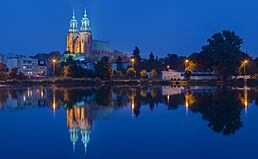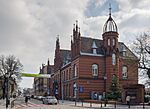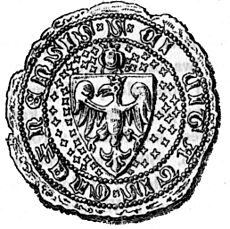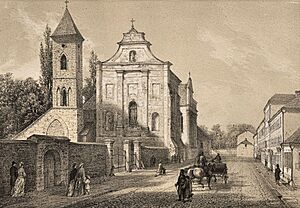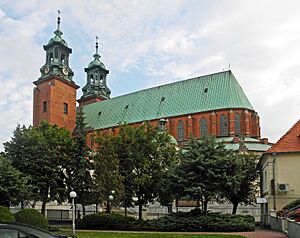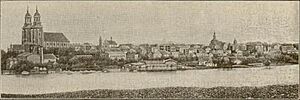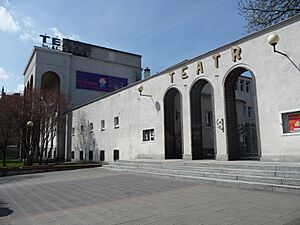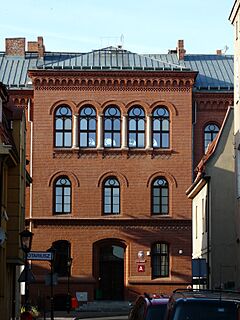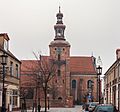Gniezno facts for kids
Quick facts for kids
Gniezno
|
|||
|---|---|---|---|
| Royal Capital City of Gniezno Stołeczne Królewskie Miasto Gniezno |
|||
|
|||
|
|||
| Country | |||
| Voivodeship | |||
| County | Gniezno | ||
| Gmina | Gniezno (urban gmina) | ||
| Established | 8th-10th century | ||
| City rights | 1239 | ||
| Area | |||
| • Total | 49 km2 (19 sq mi) | ||
| Population
(31 December 2021)
|
|||
| • Total | 66,769 |
||
| Time zone | UTC+1 (CET) | ||
| • Summer (DST) | UTC+2 (CEST) | ||
| Postal code |
62–200 to 62–210
|
||
| Area code(s) | +48 61 | ||
| Car plates | PGN | ||
| Climate | Dfb | ||
| National roads | |||
| Website | http://www.Gniezno.eu | ||
Gniezno ([ˈɡɲeznɔ]; Latin: Gnesna) is a city in central-western Poland. It is about 50 kilometers (31 miles) east of Poznań. In 2021, its population was 66,769 people. This makes it the sixth-largest city in the Greater Poland Voivodeship.
Gniezno was one of the main cities for the Piast dynasty. It was the first historical capital of Poland in the 10th and early 11th centuries. Old records from the 10th century mention it as the capital of early Poland.
Today, Gniezno is home to the Roman Catholic Archdiocese of Gniezno. This is the oldest archdiocese in Poland, started in the year 1000. The archbishop of Gniezno is also the Primate of Poland. This means Gniezno is the country's main religious center. The city is also the administrative center of Gniezno County.
Contents
Exploring Gniezno's Location
Gniezno is a historic city in the Greater Poland region. This area is known as the birthplace of the Polish state. Like Rome, Gniezno was built on seven hills. One important hill is Lech Hill, where the famous Gniezno Cathedral stands. Another is Panieńskie Hill, home to the main Market Square (Rynek).
The city also has five lakes within its borders. These include Winiary, Jelonek, Świętokrzyskie, Koszyk, and Zacisze.
Gniezno's Rich History
People have lived in the Gniezno area since the late Paleolithic (Stone Age). Early Slavic settlements on Lech Hill and Maiden Hill date back to the 8th century. In the early 10th century, these places were important for the Slavic religion. A ducal stronghold, or fortified settlement, was built on Lech Hill just before 940. It was surrounded by smaller fortified areas and open villages.
The Legend of Lech, Czech and Rus
A famous Polish legend tells the story of three brothers: Lech, Czech, and Rus. They went hunting together but followed different paths. Rus went east, Czech went west, and Lech traveled north.
While hunting, Lech followed his arrow and saw a fierce white eagle protecting its nest. The eagle was set against the red of the setting sun. Lech saw this as a good sign and decided to settle there. He named his settlement Gniezno. This name comes from the Polish word gniazdo, which means 'nest'. He also chose the White Eagle as his symbol.
The white eagle is still a symbol of Poland today. The colors of the eagle and the setting sun are on Poland's coat of arms and its flag. The white stripe is for the eagle, and the red stripe is for the sunset.
Birthplace of the Polish State
Around 940, Gniezno became a key fortress for the early Piast rulers. This was because it was an important pagan religious center. In 2010, archaeologists found an 11th-century tomb on Lech Hill. This suggests that rulers might have been buried there even before Mieszko I of Poland became Christian.
After Mieszko I became Christian, his son Bolesław I the Brave brought the remains of Saint Adalbert to a new church on Lech Hill. This showed Gniezno's importance as a religious and capital city.
The Congress of Gniezno
In the year 1000, a very important meeting called the Congress of Gniezno took place here. Bolesław I the Brave, who was the Duke of Poland, met with Holy Roman Emperor Otto III. They celebrated the creation of the Polish church province, or archbishopric, in Gniezno. New bishoprics were also set up in other cities like Kołobrzeg, Wrocław, and Kraków.
A Place for Royal Coronations
The Gniezno Cathedral saw the coronations of two Polish kings. Bolesław I was crowned here in 1024, and his son Mieszko II Lambert in 1025.
In 1038, the Bohemian duke Bretislav I attacked and destroyed Gniezno and nearby Poznań. This made the next Polish rulers move the capital to Kraków. The cathedral was rebuilt by Bolesław II the Generous, who was crowned king there in 1076.
Gniezno continued to grow as an important regional center. In 1238, it gained city rights. It was also a coronation site again in 1295 and 1300.
Gniezno as a Regional Center
After some changes in government, Gniezno became a royal city and a county seat. It was damaged during an invasion by the Teutonic Knights in 1331. However, King Casimir III the Great soon rebuilt the city.
In 1419, the archbishops of Gniezno were given the title of Primate of Poland. This confirmed Gniezno's role as "the capital of Christianity in Poland." Trade and crafts thrived in Gniezno. It remained a major Polish city until the mid-17th century, even after fires in 1515 and 1613.
The city suffered during the Polish-Swedish wars in the 17th and 18th centuries and from a plague. This caused its population to drop and its economy to decline. But Gniezno recovered in the 18th century. It became the capital of the Gniezno Voivodeship in 1768. Gniezno remained an important cultural center in Poland.
Modern Times in Gniezno
In 1793, Gniezno was taken over by the Kingdom of Prussia during the Second Partition of Poland. It was renamed Gnesen. During the Kościuszko Uprising in 1794, the Polish army briefly freed the town. However, the Prussians took it back later that year.
During the Napoleonic Wars, there was an uprising against Prussian rule. The French army arrived in Gniezno in 1806. The city became part of the Duchy of Warsaw. But after Napoleon's defeat, Gniezno was returned to Prussia in 1815.
Gniezno was a key center for Polish resistance against German policies. Many Polish groups and publishers were located there. In 1903, some Polish children and teachers in Gniezno were arrested. They were accused of studying Polish culture and "conspiring against the Prussian State."
After the Greater Poland Uprising (1918–1919) and the Treaty of Versailles, Gniezno became part of the Second Polish Republic. Many citizens of Gniezno joined the Polish army to fight during the Polish–Soviet War. The first Polish folk high school was opened in the Dalki district in 1921.
Gniezno During World War II
During World War II, German troops captured Gniezno on September 11, 1939. It was then added to Nazi Germany. During the German occupation, many local Poles were arrested, forced to leave their homes, or killed. Hundreds of people were murdered, and over 10,000 were forced to move or sent to Nazi concentration camps.
A camp was set up in the city for Poles who were forced out of their homes. Even 12-year-old Polish children were forced to work. In late 1940, many patients from a nearby psychiatric institute were killed.
Despite this, Gniezno remained a center of Polish resistance. Groups like the Tajna Organizacja Narodowa (Secret National Organization) were formed there.
The Red Army took control of the city on January 21, 1945. The city itself was not badly damaged during the war. However, the Germans had destroyed a monument of King Bolesław I the Brave in 1940, which was rebuilt after the war. Gniezno was returned to Poland, but with a communist government until the 1980s.
Gniezno After the War

In August 1980, workers in Gniezno joined nationwide strikes against the communist government. This led to the creation of the Solidarity organization, which helped end communist rule in Poland.
Pope John Paul II visited Gniezno in 1979 and 1997. During his second visit, there were big celebrations for the 1000th anniversary of St. Adalbert's death. Presidents from seven Central European countries and 280,000 pilgrims attended. In 2000, the 1000th anniversary of the Congress of Gniezno was celebrated. The Polish Parliament (Sejm) even held a session in Gniezno for this special occasion.
Archbishops of Gniezno
The Roman Catholic archbishop of Gniezno is traditionally the Primate of Poland. This is a very important religious title. For a while, the Gniezno archbishopric was combined with others. But in 1992, Pope John Paul II made Gniezno's archbishopric separate again. Today, the Archbishop of Gniezno is once again the Primate of Poland.
Kings Crowned in Gniezno Cathedral
The Gniezno Cathedral was the site of several royal coronations:
- 25 December 1024 – Bolesław I the Brave
- 25 December 1025 – Mieszko II Lambert and his wife Richeza of Lotharingia
- 25 December 1076 – Bolesław the Generous and his wife Wyszesława of Kiev
- 26 June 1295 – Przemysł II and his wife Margaret of Brandenburg
- August 1300 – Wenceslaus II of Bohemia
Population of Gniezno
| Historical population | ||
|---|---|---|
| Year | Pop. | ±% |
| 1912 | 25,339 | — |
| 1980 | 62,400 | +146.3% |
| 1990 | 70,400 | +12.8% |
| 1995 | 71,000 | +0.9% |
| 2021 | 66,769 | −6.0% |
Places to See in Gniezno
Here are some of the important and interesting places in Gniezno:
- Gniezno Cathedral: This is a beautiful Gothic church and one of Poland's most important historical buildings. It's the seat of the oldest archdiocese in Poland. Inside, you can see the Gniezno Doors, which are famous Romanesque art, and the coffin of Saint Adalbert of Prague.
- Gniezno Old Town: This area is full of old houses, buildings, and churches, including:
- Holy Trinity church (Gothic and Baroque style)
- Franciscan church and monastery (Gothic and Baroque style)
- Saint John the Baptist church (Gothic style)
- Saint Lawrence church (Gothic style)
- Saint George church (Baroque style)
- Saint Michael Archangel church (Gothic style)
- Museum of the Origins of the Polish State (Muzeum Początków Państwa Polskiego)
- Museum of Archdiocese of Gniezno (Muzeum Archidiecezjalne w Gnieźnie)
- Monument of King Bolesław I the Brave
- Gniezno locomotive depot
Education in Gniezno
Gniezno has several places for higher education:
- Collegium Europaeum Gnesnense (part of Adam Mickiewicz University in Poznań)
- The Gniezno School of Humanism and Management - Millennium
- The Primate's Major Seminary
- The State Vocational College in Gniezno
Arts and Culture
- Aleksander Fredro Theatre
- Museum of the Polish State Origins
- Museum of Archdiocese
Sports in Gniezno
The most popular sports club in Gniezno is the motorcycle speedway team Start Gniezno. An annual speedway event, the Bolesław Chrobry Tournament, is held here. The city's main football club is Mieszko Gniezno. The E11 European long distance path for hikers also passes through Gniezno.
Famous People from Gniezno
- Hermann Senator (1834–1911), a German physician
- Jacob Caro (1836–1904), a German historian
- Ludwik Ćwikliński (1853–1942), a Polish classical scholar
- Felix Waldstein (1862–1943), a German politician
- Kurt Jahnke (1882–1945), a German-American intelligence agent
- Günther Pancke (1889–1973), a German SS General
- Heinz Reinefarth (1903–1979), a German SS General
- Alfons Flinik (1926–2003), a Polish field hockey player
- Paweł Arndt (born 1954), a Polish politician
- Arkadiusz Radomski (born 1977), a Polish footballer
- Łukasz Cieślewicz (born 1987), a Polish footballer
- Marika Popowicz-Drapała (born 1988), a Polish athlete
- Kacper Gomólski (born 1993), a Polish speedway rider
Sister Cities
Gniezno has special connections with these cities:
 Anagni, Italy
Anagni, Italy Esztergom, Hungary
Esztergom, Hungary Falkenberg, Sweden
Falkenberg, Sweden Saint-Malo, France
Saint-Malo, France Speyer, Germany
Speyer, Germany Radviliškis, Lithuania
Radviliškis, Lithuania Uman, Ukraine
Uman, Ukraine Veendam, Netherlands
Veendam, Netherlands
Gniezno used to be a sister city with Sergiyev Posad, Russia. However, in March 2022, Gniezno ended this connection because of the 2022 Russian invasion of Ukraine.
Images for kids
-
Monument of King Bolesław I the Brave with the Cathedral in the background
See also
 In Spanish: Gniezno para niños
In Spanish: Gniezno para niños


